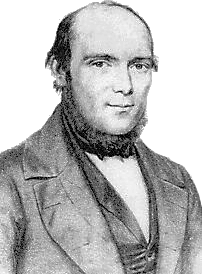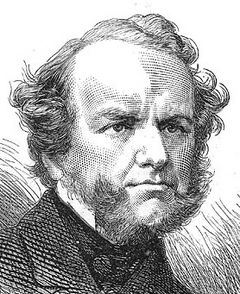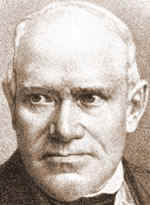Adolf Anderssen facts for kids
Quick facts for kids Adolf Anderssen |
|
|---|---|
 |
|
| Full name | Karl Ernst Adolf Anderssen |
| Country | Prussia |
| Born | July 6, 1818 Breslau, Kingdom of Prussia, German Confederation |
| Died | March 13, 1879 (aged 60) Breslau, Kingdom of Prussia, German Empire |
Karl Ernst Adolf Anderssen (born July 6, 1818 – died March 13, 1879) was a famous German chess master. He won important international chess tournaments in 1851 and 1862. Many people considered him the best chess player in the world from 1851 to 1858. After 1862, he was seen as the top active player until 1866. The official title of World Chess Champion did not exist yet.
Anderssen was very successful in chess tournaments in Europe. He won more than half of the events he played in. This included the very strong Baden-Baden 1870 chess tournament. He achieved many of these wins when he was over 50 years old.
Today, Anderssen is known for his exciting and bold attacking style. He often made surprising sacrifices of his pieces to win games. His most famous games are the "Immortal Game" (1851) and the "Evergreen Game" (1852). He also helped develop chess problems, making them more complex and elegant. Anderssen was a well-liked chess master. Other players often asked him for advice or to help settle disagreements.
Contents
Adolf Anderssen's Early Life and Education
Anderssen was born in Breslau, which is now called Wrocław in Poland. This was in the Prussian region of Silesia in 1818. He lived in Breslau for most of his life. He shared a home with his widowed mother and his unmarried sister. Anderssen never got married.
He went to a public high school in Breslau. Then he studied mathematics and philosophy at university. After finishing his studies in 1847, when he was 29, he became a teacher. He taught mathematics at the Friedrichs-Gymnasium. Later, he became a professor there. Anderssen lived a quiet and responsible life. Teaching mathematics was his job, but playing chess was his favorite hobby and passion.
When Anderssen was nine years old, his father taught him how to play chess. Anderssen said he learned chess strategy from a book. It was called Fifty Games between Labourdonnais and McDonnell (1835) by William Lewis.
Anderssen's Chess Journey
First Steps in Chess
|
From Anderssen's 1842 collection
White to mate in four moves
Solution: 1.Bh5 Kxh5 2.Kg7 h6 3.Kf6 Kh4 4.Kg6# |
||||||||||||||||||||||||||||||||||||||||||||
|
||||||||||||||||||||||||||||||||||||||||||||
Anderssen first became known in the chess world in 1842. He published a book called Aufgabe für Schachspieler ("Task for chess players"). It was a collection of 60 chess problems. He kept publishing problems for many years in magazines. He also released a second collection in 1852. These problems caught the attention of the "Berlin Pleiades" group. This group included some of the strongest players at that time. Anderssen played matches against some of them.
Anderssen's skills as a player grew slowly. This was because he did not have much time or money to play against many strong opponents. However, by 1846, he was a strong player. He played a good match against Tassilo von Heydebrand und der Lasa, who was likely the world's best player then. In 1846, Anderssen became the editor of the magazine Schachzeitung der Berliner Schachgesellschaft. He took over after its founder, Ludwig Bledow, died. Anderssen stayed in this job until 1865.
Winning in London: 1851 Tournament

In 1848, Anderssen played a match against professional player Daniel Harrwitz and it ended in a draw. Because of this match and his growing reputation, he was invited to the first international chess tournament. This big event was held in London in 1851. Anderssen was not sure about going because of the travel costs.
However, the main organizer of the tournament, Howard Staunton, made a generous offer. He said he would pay Anderssen's travel costs himself if Anderssen did not win a prize. Anderssen accepted this offer. Before the tournament, Anderssen practiced a lot. He played over 100 games against strong players.
The 1851 International Tournament was a knock-out event. Players competed in short matches. Anderssen won the tournament by beating several top players. He defeated Lionel Kieseritzky, József Szén, Staunton, and Marmaduke Wyvill. He won each match by at least two games. His prize was about £335, which was a lot of money back then. It would be like over £240,000 today.
Even though Wilhelm Steinitz is often called the first true world champion, one organizer of the 1851 tournament said it was for "the baton of the World's Chess Champion." Anderssen was not officially called "world champion." But the tournament showed that he was the leading chess player in the world. The London Chess Club held another tournament a month later. Anderssen won that one too.
The Morphy Match in 1858

It was rare to have chess tournaments back then. Anderssen also did not like to travel far because it was expensive. In 1857, he played in a knock-out tournament in Manchester. He was eliminated in the second round. Then, in late 1858, he played a famous match against the American champion Paul Morphy in Paris, France. Anderssen lost this match 8–3 (with two wins, two draws, and seven losses).
Anderssen was great at attacking, but Morphy was even better. Morphy knew exactly when and how to prepare an attack. Morphy had recently won easily against other strong players. Morphy went back to the United States in 1859. He soon stopped playing serious chess. This made Anderssen the strongest active player again.
In three games against Morphy, Anderssen started with the unusual move 1.a3. He had mixed results with it (one loss, one draw, one win). This opening move is now called "Anderssen's Opening." It has never been very popular in serious chess games.
Famous Games and Other Matches (1851–1862)
Soon after the 1851 London tournament, Anderssen played his two most famous games. These were casual games, but he won them with amazing combinations and many sacrifices. The first game was in London on June 21, 1851, against Lionel Kieseritzky. It is called the "Immortal Game." In this game, Anderssen, playing as White, sacrificed a bishop, both rooks, and finally his queen to win!
The second famous game was in Berlin in 1852 against Jean Dufresne. It is known as the "Evergreen Game." In this game, Anderssen's sacrifices were not as many as in the Immortal Game, but he still gave up a queen and a minor piece to win.
After his match with Morphy, Anderssen played two matches against Ignác Kolisch. Kolisch was a top player who later became a rich banker and supported chess. Anderssen drew their match in 1860. He then won a close match in 1861 (5 wins, 2 draws, 3 losses).
Winning Again: London 1862
Anderssen won the London 1862 chess tournament. This was the first international round-robin tournament. In this type of tournament, every player plays against every other player. Anderssen won 12 out of 13 games. He only lost one game to Rev. John Owen. He finished two points ahead of Louis Paulsen, who was a very strong player. Since Morphy had stopped playing chess, Anderssen was again seen as the world's leading active player.
After the tournament, Anderssen played a match against Paulsen, who finished second. The match ended in a draw (3 wins, 3 losses, 2 draws). In 1864, he drew another match (3 wins, 3 losses, 2 draws) against Berthold Suhle. Suhle was a strong player and a respected chess writer.
The Steinitz Match in 1866

In 1866, Anderssen lost a close match to 30-year-old Wilhelm Steinitz. Steinitz won eight games, and Anderssen won six (with no draws). Steinitz won the last two games. Steinitz is famous for developing a new, more careful way of playing chess, called the positional approach. However, the 1866 match was played in the attacking style popular in the 1850s and 1860s.
This match is often seen as the point when Steinitz became the world's leading active player. People had been talking about a world championship since the 1840s. But the 1866 Anderssen–Steinitz match was not officially for the world championship. Many people felt that no one should claim that title while Morphy was still alive and retired from chess. Also, Anderssen continued to be very strong in tournaments and matches against other players like Zukertort until 1871.
Later Career (1866–1879)
By this time, chess tournaments were happening more often. The round-robin format, where everyone plays everyone, became common. After losing to Morphy in 1858 and Steinitz in 1866, Anderssen worked even harder on his chess. He studied endgames and positional play. This helped Anderssen, in his early fifties, play some of the best chess of his life.
He had a very successful record in tournaments during this later part of his career. He won five first places, two second places, and two third places. In his last year, when his health was not good, he finished sixth at a tournament in Paris. One of his first-place wins was at the Baden-Baden 1870 chess tournament. He finished ahead of Steinitz, Gustav Neumann, Joseph Henry Blackburne, and other strong players. This tournament is considered one of the top 20 tournaments ever because so many leading players were there.
One of Anderssen's third-place finishes was at the strong Vienna 1873 tournament. He was 55 years old then. About half of Anderssen's tournament wins were at championships for German Chess Federations. These events were open to players from all countries. Anderssen usually beat Johannes Zukertort in matches, but Zukertort started winning against him in 1871.
The Leipzig 1877 tournament was held to honor Anderssen. It was called the "Anderssen-Feier" (Anderssen Celebration). Anderssen finished second in this tournament, behind Louis Paulsen. Also in Leipzig, Anderssen lost a match against Louis Paulsen. Matches were Anderssen's weaker point. His only match win in this period was in 1868 against 26-year-old Johannes Zukertort.
How Good Was Anderssen?
Playing Strength and Style
Anderssen was very successful in European tournaments from 1851 to early 1878. He won first prize in more than half of the events he played. His only real tournament failures were a knock-out event in 1857 and a sixth-place finish at Paris 1878, when he was in poor health. His record in matches was not as strong. He played 12 matches, winning only two, drawing four, and losing six.
Even though Paul Morphy and Wilhelm Steinitz were considered stronger, Anderssen is often called the first modern chess master.
Arpad Elo, who created the Elo rating system for chess players, estimated that Anderssen was the first player to have a rating over 2600. The Chessmetrics system ranks Anderssen as one of the top two players for most of the years between 1859 and 1873. It even ranks him as the strongest player in the world for seven months between 1860 and 1870.
Steinitz, a later world champion, said Anderssen was one of the two greatest attacking players of his time. He said, "We all may learn from Morphy and Anderssen how to conduct a king's-side attack." Anderssen was part of the "heroic" attacking style of chess. However, he did not believe in just attacking without thinking. He once said, "Move that one of your pieces, which is in the worst plight, unless you can satisfy yourself that you can derive immediate advantage by an attack." This idea is similar to "Makogonov's rule."
Anderssen's hometown was very proud of him. In 1865, Breslau University gave him an honorary doctorate degree.
Anderssen's Impact on Chess
Some of Anderssen's games, like the Immortal Game and the Evergreen Game, are among the most famous in chess history. This is because of their beautiful attacking style.
The "heroic" attacking style that Anderssen used was later replaced by Steinitz's more careful, positional approach. By 1894, most people agreed that to beat Steinitz, you had to use his own principles.
Anderssen had a lasting impact on chess problem composition. He started creating problems when the "Old School" was still popular. These problems looked like real game positions and had exciting first moves and many sacrifices. Anderssen was one of the most skilled problem composers of his time. His work helped start the "Transition Period" in chess problems. During this time, from the mid-1840s to the early 1860s, many new problem ideas were found. The need for game-like positions was dropped. Also, chess problem competitions began in 1854, which made judges decide what made a problem good.
Anderssen did not write many books outside of chess problems. However, he edited the magazine Schachzeitung der Berliner Schachgesellschaft from 1846 to 1865. He also co-edited Neue Berliner Schachzeitung with Gustav Neumann from 1864 to 1867.
Anderssen's Personality
It is impossible to keep one's excellence in a glass case, like a jewel, and take it out whenever it is required.
Wilhelm Steinitz wrote about Anderssen: "Anderssen was honest and honorable to the core. He always gave his opinion directly, without fear or favor. His sincere fairness was so clear that his word alone was usually enough to stop arguments." Steinitz also noted that Anderssen often made decisions that favored his rivals. However, Reuben Fine, a chess player from the 20th century, wrote that there was a strange difference between Anderssen's brilliant play and his careful, safe approach to everyday life.
Adolf Anderssen's Death
Anderssen passed away on March 13, 1879, in his hometown of Breslau. The Deutsche Schachzeitung chess magazine published a long obituary about him in 1879. He died from a heart attack.
During World War II, bombing raids damaged his grave in Breslau. After the war, the city became part of Poland and is now known as Wrocław. In 1957, the Polish Chess Federation decided to re-bury Anderssen in a new grave. This new grave is at the Osobowice Cemetery.
Tournament Results
| Date | Location | Place | Score | Notes |
|---|---|---|---|---|
| 1851 | London International Tournament | 1 | 15/21 | Won a knock-out tournament, beating Marmaduke Wyvill, Elijah Williams, Howard Staunton, József Szén, Hugh Alexander Kennedy, Bernhard Horwitz, Henry Edward Bird, Lionel Kieseritzky, Carl Mayet, Johann Löwenthal, Edward Löwe, Alfred Brodie, James Mucklow, Samuel Newham, and E.S. Kennedy. |
| 1851 | London Chess Club Tournament | 1 | 7½/8 | Finished ahead of Karl Meyerhofer, Daniel Harrwitz, Frederick Deacon, Kieseritzky, Horwitz, Szabo, Löwe, and Ehrmann. |
| 1857 | Manchester (British Chess Association) | 3/4 | 1/2 | A knock-out tournament. Anderssen won in the 1st round but lost in the 2nd round. |
| 1862 | London International Tournament | 1 | 12/13 | Finished ahead of Louis Paulsen, Rev. Owen, George Alcock MacDonnell, Serafino Dubois, Wilhelm Steinitz and 8 others. This was one of the first successful round-robin tournaments. |
| 1868 | Aachen (West German Chess Federation) | 1= | 3/4 then 0/1 |
Tied for 1st with Max Lange; Lange won the playoff. |
| 1869 | Hamburg (North German Chess Federation) | 1= | 4/5 then 1½/2 |
Tied for 1st with Louis Paulsen; Anderssen won the playoff. |
| 1869 | Barmen (West German Chess Federation) | 1 | 5/5 | Finished ahead of Zukertort, von Minckwitz, Schallopp and Wilfried Paulsen and Richard Hein. |
| 1870 | Baden-Baden International Tournament | 1 | 11/18 | Finished ahead of Steinitz, Gustav Neumann, Joseph Henry Blackburne, Louis Paulsen, Cecil Valentine De Vere, Szymon Winawer, Samuel Rosenthal, von Minckwitz and Adolf Stern. |
| 1871 | Krefeld (West German Chess Federation) | 1= | 4/5 then 1/2 |
Tied for 1st with von Minckwitz and Louis Paulsen; Paulsen won the playoff. |
| 1871 | Leipzig (Central German Chess Federation) | 1= | 4½/5 then 1/1 | Tied for 1st with Samuel Mieses; Anderssen won a playoff game. |
| 1872 | Altona (North German Chess Federation) | 1 | 3½/4 | Finished ahead of Neumann, Göring, Schallopp and Pitschel. |
| 1873 | Vienna International Tournament | 3 | 8½/11: 19/30 | Finished behind Steinitz and Blackburne. |
| 1876 | Leipzig (Central German Chess Federation) | 1= | 3½/5 then 2/2 | Tied for 1st with Goering and Pitschel; Anderssen won the playoff. |
| 1877 | Leipzig (Central German Chess Federation) | 2= | 8½/11 | Finished behind Louis Paulsen; tied with Zukertort. This tournament honored Anderssen's 50th anniversary of learning chess. |
| 1878 | Frankfurt (West German Chess Federation) | 3 | 6/9 | Finished behind Louis Paulsen and Adolf Schwarz. |
| 1878 | Paris International Tournament | 6 | 12½/22 | Anderssen was in poor health. The event was won by Winawer and Zukertort. |
Match Results
| Date | Opponent | Result | Location | Score | Notes | |
|---|---|---|---|---|---|---|
| 1845 | Ludwig Bledow | Lost | Breslau | ½/5 | +0=1–4 | |
| 1845–1846 | Tassilo von der Lasa | Lost | Breslau | 2/6 | +2=0–4 | |
| 1848 | Daniel Harrwitz | Drew | Breslau | 5/10 | +5=0–5 | |
| 1851 | Tassilo von der Lasa | Lost | Breslau | 5/15 | +?=?–? | |
| 1851 | Karl Pitschel | Drew | Leipzig | 2/4 | +1=2–1 | |
| 1851 | Jean Dufresne | Won | Berlin | 13/18 | +12=2–4 | |
| 1851 | Ernst Falkbeer | Won | Berlin | 4/5 | +4=0–1 | |
| 1851 | Carl Mayet | Won | Berlin | 4/4 | +4=0–0 | |
| 1851 | Eduard Jenay | Won | London | 4½/8 | +?=?–? | Casual games |
| 1851 | Lionel Kieseritzky | Lost | London | 6/16 | +5=2–9 | Casual games |
| 1851 | Johann Löwenthal | Won | London | 5½/8 | +5=1–2 | Casual games |
| 1858 | Daniel Harrwitz | Won | Paris | 4/6 | +3=2–1 | |
| 1858 | Paul Morphy | Lost | Paris | 3/11 | +2=2–7 | |
| 1858 | Paul Morphy | Lost | Paris | 1/6 | +1=0–5 | Casual games |
| 1859 | Max Lange | Lost | Breslau | 3½/8 | +3=1–4 | Casual games |
| 1859 | Carl Mayet | Won | Berlin | 7/8 | +7=0–1 | |
| 1859 | Jean Dufresne | Won | Berlin | 4/4 | +4=0–0 | |
| 1859 | Berthold Suhle | Won | Berlin | 31/48 | +27=8–13 | Casual games |
| 1860 | Philipp Hirschfeld | Won | Berlin | 16½/29 | +14=5–10 | |
| 1860 | Ignatz von Kolisch | Drew | Paris | 5½/11 | +5=1–5 | |
| 1860 | Paul Journoud | Won | Paris | 3½/5 | +3=1–1 | |
| 1860 | Jules Arnous de Rivière | Drew | Paris | 2½/5 | +2=1–2 | |
| 1861 | Ignatz von Kolisch | Won | London | 5/9 | +4=2–3 | |
| 1861 | Johann Löwenthal | Won | London | 2/3 | +2=0–1 | Casual games |
| 1862 | Louis Paulsen | Drew | London | 4/8 | +3=2–3 | |
| 1862 | Wilhelm Steinitz | Won | London | 2/3 | +2=0–1 | Casual games |
| 1864 | Berthold Suhle | Drew | Berlin | 4/8 | +3=2–3 | |
| 1865 | Carl Mayet | Won | Berlin | 5½/8 | +5=1–2 | |
| 1866 | Johannes Minckwitz | Won | Berlin | 8½/12 | +8=1–3 | |
| 1866 | Gustav Neumann | Lost | Berlin | 10/24 | +9=2–13 | |
| 1866 | Wilhelm Steinitz | Lost | London | 6/14 | +6=0–8 | |
| 1867 | Samuel Mieses | Won | Breslau | 4½/5 | +4=1–0 | |
| 1868 | Johannes Zukertort | Won | Berlin | 8½/12 | +8=1–3 | |
| 1870 | Louis Paulsen | Lost | Baden-Baden | ½/3 | +0=1–2 | |
| 1871 | Johannes Zukertort | Lost | Berlin | 2/7 | +2=0–5 | |
| 1876 | Louis Paulsen | Lost | Leipzig | 4½/10 | +4=1–5 | |
| 1877 | Louis Paulsen | Lost | Leipzig | 3½/9 | +3=1–5 | |
See also
 In Spanish: Adolf Anderssen para niños
In Spanish: Adolf Anderssen para niños
Images for kids




